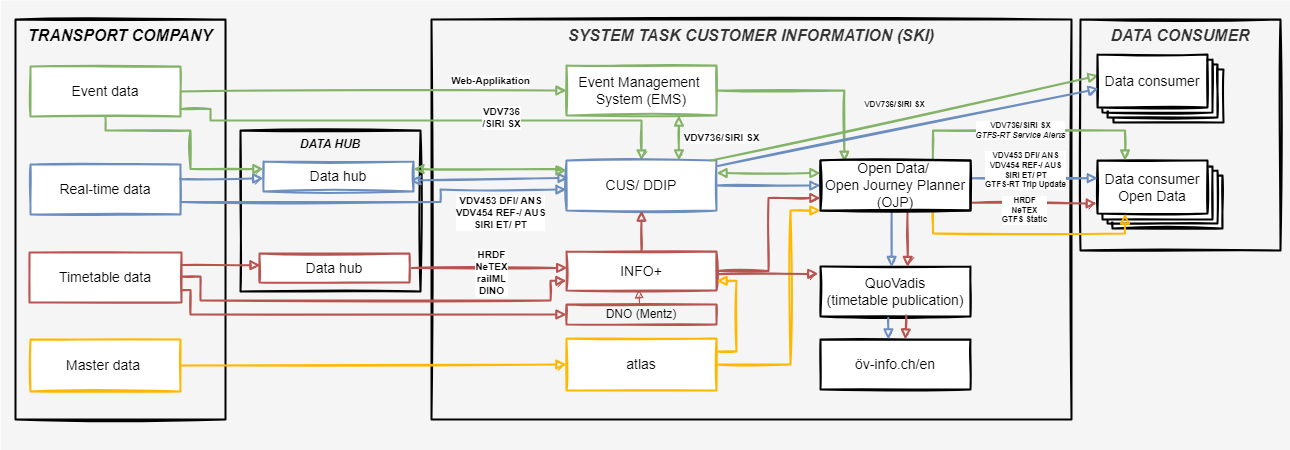Big Picture
The aim of the Big Picture below is to indicate the rough general connections involved from the data sources to the publishing of information/data.

Sources
The complex and variable nature of transport companies is not represented in the Big Picture. But there are very many solutions and different forms used. For instance, one transport company will use Excel, while another will use a fully integrated system for all the layers.
However, there are essentially three different layers involved with transport companies::
- Stops: represent the foundation of public transport and are therefore identified and managed throughout Switzerland by the national ATLAS (before DiDok) system.
- Timetable system: Each transport company creates the timetables that are to be communicated to the customer. On the one hand, the transport company itself publishes the timetables (e.g. as a poster attached the stop). On the other hand, the timetable data must be incorporated into a larger pool.
- The (operations) control system is used for ad hoc assignment. This means that the changes in relation to the original plan are either registered (e.g. delays) or actively implemented (diversions). However, this layer also includes very simple systems (such as a mobile phone), which only register the current position and calculate the forecast.
In actual fact, there are numerous systems used by many transport companies which can behave in very different ways in terms of not only processing, but also supplying data. This disparity is explained and simplified in the section on intermediate steps.
Intermediate steps
The data is collated before it is published. This involves, as an initial step, the data being merged at a regional collection point or regional data hub. The Big Picture is also simplified at this stage as the regional systems can include fully integrated systems (e.g. interconnected systems), systems from a nationally operating company (e.g. Postauto) or a hub which collects data nationally (e.g. Bernmobil). Here, too, there is more than one system per shift (exception: stops), but not as many as with the source systems.
Sooner or later, however, the data will end up in the three national systems ATLAS (before DiDok) (stops), INFO+ (timetable) or CUS (real-time). Currently, only ATLAS (before DiDok) and INFO+ can assume that all TUs in Switzerland have submitted the relevant data. Not all TUs supply real-time data to CUS. There are two reasons for this:
- Not every transport company has an (operations) control system.
- Not every transport company which has an (operations) control system or not every data hub supplies data in the desired format.
However, the aim is for all transport companies in Switzerland, over time, to supply real-time data.
Publication
The data is transferred from the national collection systems to two publication systems:
- QuoVadis: QuoVadis prepares the data so that it can be published on öv-info.ch (German, French & Italian only). This includes both the draft timetable (i.e. the annual timetable for checking before it is valid, German only) and the currently valid (annual) timetable (German, French & Italian only).
- Open Data Platform Mobility Switzerland (this page): There is also an upstream system here that prepares and collates the data, but it is fully integrated so that all data can be published in consolidated form on opentransportdata.swiss. This platform also collates the data from the various layers in the national systems, thereby ensuring that the output is suitably integrated. In particular, both the draft timetable and the timetable (in raw data form) are published on this page.
The Open Data Platform Mobility Switzerland
Behind the national systems (ATLAS (before DiDok), INFO+, and CUS, as well as other systems not specified here) is the Customer Information System Tasks (SKI) team (German, French & Italian only). The SKI works on behalf of the Federal Office of Transport (FOT). More precisely, the FOT has commissioned SBB Infrastructure to collect, consolidate and publish passenger information data for Swiss public transport (öV-CH).
The Swiss Mobility Open Data Platform is in turn managed by the Customer Information Plus (SKI+) system tasks team (as part of SKI; German, French & Italian only). SKI+ supports the FOT in its preparations for the NADIM (National Data Networking Infrastructure Mobility). With NADIM, the federal government wants to enable efficient, climate-friendly, inclusive and safe mobility and ensure international connectivity with the EU. To this end, the SKI+ team operates this platform and the Open Journey Planner with partners/suppliers and is involved in the design of the NADIM services. In addition, and against the background of the implementation of the future NADIM, SKI+ is publishing the uniform (interface) standards (German, French & Italian only) on behalf of the FOT in order to make a positive contribution towards harmonising the system landscape in public transport.